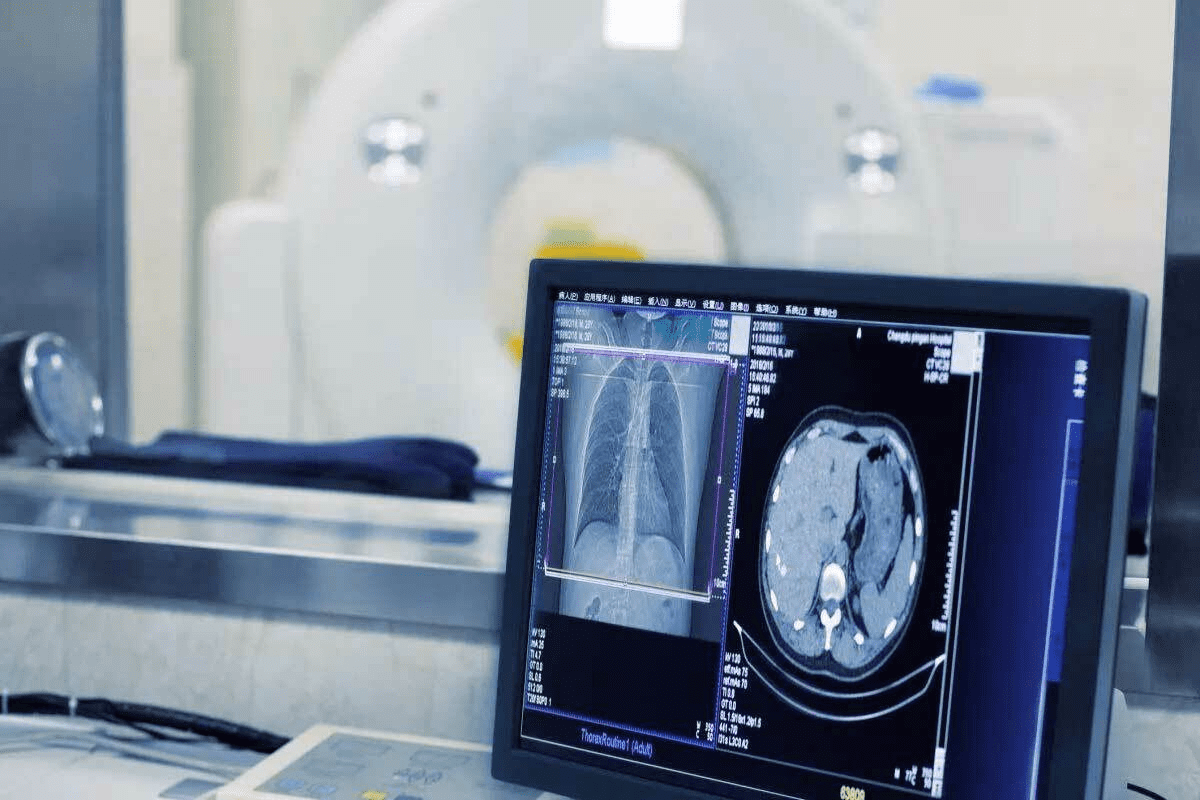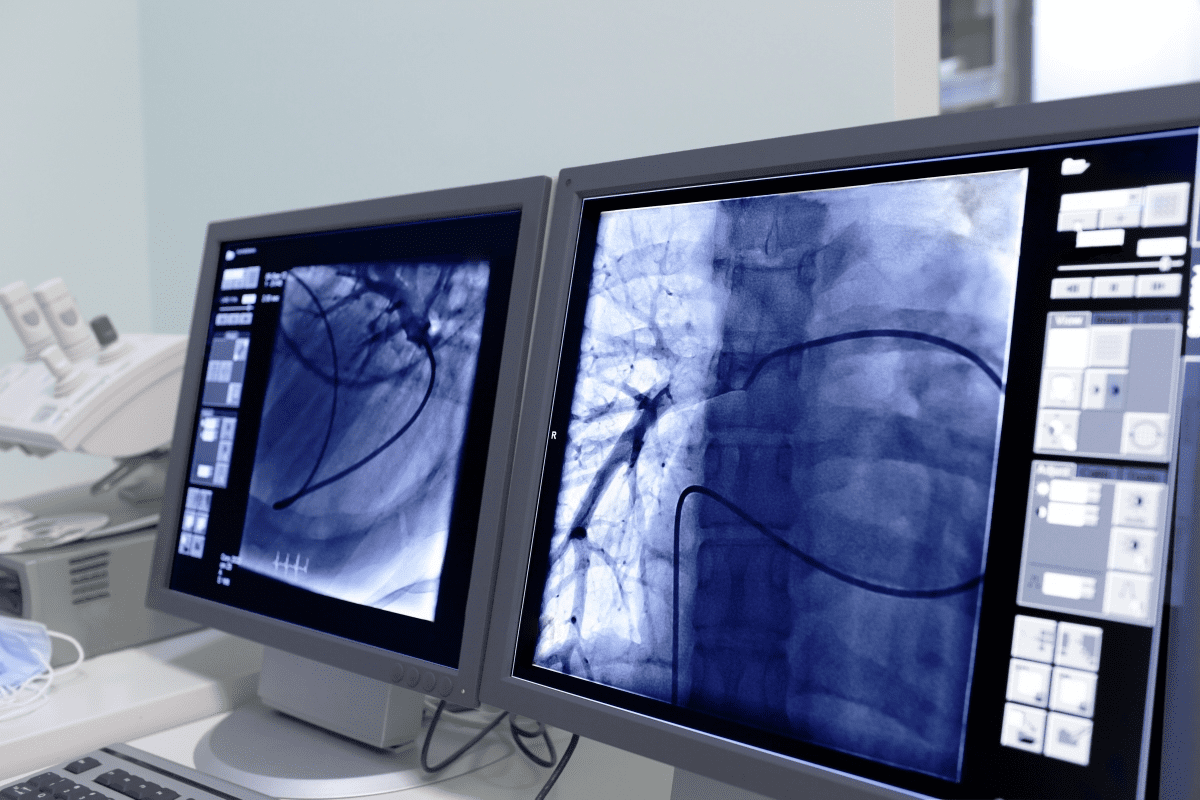Last Updated on November 26, 2025 by Bilal Hasdemir

At Liv Hospital, we know how tough chronic back pain and nerve issues can be. Epidural steroid injections are a common solution for these problems. Epidural injections help by putting anti-inflammatory medicine right into the epidural space. This reduces inflammation and pain in the lower back or sacral area. What is NJX interlaminar lmbr sac? Discover 7 key facts about this specific type of lumbar/sacral epidural steroid injection.
NJX interlaminar lumbar and sacral epidural injections are a popular choice for pain relief. They target pain from issues like herniated discs and spinal stenosis. By focusing on the pain’s source, we help patients find relief and live better lives.
Key Takeaways
- Epidural steroid injections are a common treatment for chronic back pain and nerve-related issues.
- NJX interlaminar epidural injections deliver anti-inflammatory medication directly into the epidural space.
- These injections can provide relief from conditions such as lumbar radiculopathy and spinal stenosis.
- Liv Hospital is committed to providing advanced, ethical, and patient-focused care.
- Interlaminar epidural injections are a widely used interventional pain procedure.
What Are NJX Interlaminar Lmbr Sac Epidural Injections?

To understand NJX Interlaminar Lumbar/Sacral Epidural Injections, we need to know about the interlaminar space. This space is key in spinal anatomy. We will look at what these injections are, why they are used, and how they are done.
Definition and Medical Purpose
NJX Interlaminar Lumbar/Sacral Epidural Injections put corticosteroids near the spinal cord. They are mainly for treating inflammation in the lower back and sacral areas. This includes conditions like lumbar radiculopathy and degenerative disc disease.
The goal of these injections is to cut down inflammation and ease pain. By putting steroids directly into the epidural space, we get a stronger effect than with pills or shots.
The Interlaminar Approach Explained
The interlaminar approach is a way to get to the epidural space. It involves injecting between the vertebrae’s laminae. This method helps place medication exactly where it’s needed.
Key aspects of the interlaminar approach include:
- Targeted delivery to the epidural space
- Precision in reaching the affected nerve roots
- Minimized risk of complications when performed under imaging guidance
Anatomical Targets in Lumbar and Sacral Regions
The lumbar and sacral areas are often treated with NJX Interlaminar Epidural Injections. This is because many people have problems in these spots. The injections aim at the epidural space around the nerve roots.
| Region | Common Conditions | Target Area |
| Lumbar | Lumbar radiculopathy, herniated discs | Epidural space around L3-L5 |
| Sacral | Sacral radiculopathy, degenerative disc disease | Epidural space around S1-S4 |
Common Conditions Treated with Interlaminar Epidural Injections

We use interlaminar epidural injections to treat many spinal problems. These injections help manage chronic pain from different conditions in the lower back and sacral area.
Lumbar Radiculopathy and Nerve Pain
Lumbar radiculopathy, or sciatica, occurs when nerves in the lower back get irritated or compressed. This can cause pain, numbness, or weakness in the leg. Interlaminar epidural steroid injections can help by reducing inflammation in the affected area.
Herniated Discs and Disc Protrusions
Herniated discs happen when the soft center of the disc leaks out through a tear. This can irritate nearby nerves. Interlaminar epidural injections can ease the pain and inflammation. Our team uses imaging to place the medication exactly right.
“The use of epidural steroid injections for herniated discs has been shown to provide effective pain relief in many patients, allowing them to avoid more invasive procedures.”
Spine Specialist
Spinal Stenosis Management
Spinal stenosis occurs when the spinal canal narrows, putting pressure on the spinal cord and nerves. This can cause pain, numbness, or weakness in the back, legs, or buttocks. Interlaminar epidural injections can help manage these symptoms, providing pain relief and improving mobility.
| Condition | Symptoms | Treatment Benefit |
| Lumbar Radiculopathy | Pain, numbness, and weakness in the leg | Pain relief, reduced inflammation |
| Herniated Discs | Pain, inflammation | Reduced pain and inflammation |
| Spinal Stenosis | Pain, numbness, weakness | Improved mobility, pain relief |
Degenerative Disc Disease
Degenerative disc disease occurs when the discs between vertebrae lose height and strength over time. This can cause pain and discomfort. Interlaminar epidural injections can help manage this pain, improving the patient’s quality of life.
By targeting specific conditions with interlaminar epidural injections, we offer a minimally invasive treatment. This can significantly improve symptoms and overall well-being for patients.
The Science Behind Anti-inflammatory Effects in the Epidural Space
It’s important to know how anti-inflammatory effects work in the epidural space. This area is key for treating pain with NJX interlaminar lumbar/sacral epidural injections. It’s a fatty area between the bone and the sac around the spinal cord.
Mechanism of Action for Steroid Medications
Steroid medications work by reducing inflammation when given through epidural injections. They do this by inhibiting the production of pro-inflammatory cytokines. This means less swelling and pressure on nerves, which helps ease pain.
“The use of epidural steroid injections has been a mainstay in the treatment of lumbar radiculopathy,” as noted by various clinical studies. The steroids bind to receptors, suppressing the inflammatory process.
Distribution Patterns in the Interlaminar Space
How the steroid medication spreads in the interlaminar space is key to its success. Studies show it spreads both up and down from where it’s injected. This lets it treat more nerve roots. The spread depends on the amount of medication and the space’s anatomy.
Duration of Therapeutic Effects
The effects of steroid medications can last weeks to months. This varies by person. The type and dose of steroid, and the condition being treated, affect how long the effects last.
Physiological Response to Epidural Steroids
The body’s response to epidural steroids includes reducing inflammation and affecting the hypothalamic-pituitary-adrenal axis. While safe, high doses or frequent use can cause systemic effects. But these are rare with the doses used in interlaminar epidural injections.
Understanding the science behind anti-inflammatory effects in the epidural space shows NJX interlaminar lumbar/sacral epidural injections are a valuable treatment. They help patients with inflammatory conditions in the lumbar and sacral areas.
Image-Guided Precision: Safety and Accuracy in NJX Procedures
Image-guided precision is key in NJX interlaminar lumbar/sacral epidural injections. It ensures safety and effectiveness. We use advanced imaging to guide the injections, reducing risks and improving benefits.
Fluoroscopic Guidance Techniques
Fluoroscopic guidance is vital in NJX procedures. It lets us see the injection site in real-time. This way, we can place the needle accurately and deliver the medication to the right spot.
The benefits of fluoroscopic guidance include:
- Enhanced Accuracy: Real-time imaging ensures precise needle placement.
- Reduced Risk: Minimizes the risk of complications by avoiding critical structures.
- Improved Efficacy: Ensures that medication is delivered directly to the target area.
Patient Positioning and Preparation
Proper patient positioning and preparation are key for NJX procedures. We make sure patients are comfortable and positioned right for accurate needle placement.
Key aspects of patient preparation include:
- Pre-procedure Assessment: Evaluating the patient’s medical history and current condition.
- Positioning: Carefully positioning the patient to optimize access to the injection site.
- Sterilization: Maintaining a sterile environment to minimize the risk of infection.
Needle Placement and Medication Delivery
Accurate needle placement is vital for NJX procedures. We use fluoroscopic guidance to ensure the needle is correctly placed in the epidural space.
Once the needle is in place, we deliver a measured dose of medication to the target area. This precise delivery helps reduce inflammation and alleviate pain.
Differences Between Lumbar/Sacral and Cervical/Thoracic Approaches
NJX procedures can be done at different spinal levels, like lumbar/sacral and cervical/thoracic. Each level has its own considerations and techniques.
The main differences between these approaches include:
- Anatomical Considerations: Variations in spinal anatomy require adjustments in technique.
- Needle Placement: Different angles and approaches are used based on the spinal level being treated.
- Medication Dosage: The dose of medication may vary depending on the specific procedure and the patient’s needs.
Clinical Efficacy of NJX Interlaminar Lmbr Sac Procedures
We look into the success of NJX interlaminar lumbar sacral procedures. We focus on their success rates and how patients do after treatment. The ILESI procedure is getting more attention for treating chronic back pain and radiculopathy.
Success Rates: 50-80% Short-Term Relief
Research shows NJX interlaminar lumbar sacral procedures help a lot in the short term. Success rates are between 50% to 80%. This is very good for people with back pain and disc problems. The treatment involves putting steroid medication near the spinal cord. This reduces swelling and eases pain.
Medium-Term Outcomes and Follow-up Studies
Studies also show benefits lasting longer than just the short term. With the right patients, the results can last, with some feeling pain relief for a while. But how long this relief lasts can vary. This shows the importance of a treatment plan made just for each person.
Patient Selection Criteria for Optimal Results
Choosing the right patients is key to good results with NJX interlaminar lumbar sacral procedures. They need to have certain spinal problems and not have gotten better with other treatments. Doctors must carefully check the patient’s history, symptoms, and tests to find the best candidates.
Predictors of Successful Pain Relief
Some things can tell us if a patient will get pain relief from NJX interlaminar lumbar sacral procedures. These include how bad the symptoms are, if there’s inflammation, and how well the needle is placed. Knowing these helps doctors make treatments that are more likely to work for each patient.
By looking at these important points, we can understand more about the success of NJX interlaminar lumbar sacral procedures. They play a big role in managing pain today.
Diagnostic and Therapeutic Applications of Interlaminar Epidural Injections
Interlaminar epidural injections are key in pain management. They help doctors diagnose and treat pain. This makes them a vital part of patient care.
Dual Role in Pain Diagnosis and Treatment
These injections are used for both finding pain sources and treating them. They block nerves to find pain and give medicine to ease it.
Key diagnostic benefits include:
- Identifying the specific nerve root causing pain
- Determining the effectiveness of epidural steroid injections
- Guiding further treatment decisions based on patient response
NJX Dx/Ther Sbst Intrlmnr Lmbr/Sac W/Img Gdn: Procedure Details
The NJX Dx/Ther Sbst Intrlmnr Lmbr/Sac W/Img Gdn procedure is precise. It delivers medicine to the right spot under image guidance. This makes treatment more effective.
The procedure typically involves:
- Patient preparation and positioning
- Fluoroscopic guidance to ensure accurate needle placement
- Administration of the diagnostic or therapeutic agent
- Monitoring for patient response and possible side effects
Determining Appropriate Treatment Pathways
Interlaminar epidural injections help find the best treatment for spinal disorders. They help doctors decide if surgery or more treatment is needed.
“The use of interlaminar epidural injections as a diagnostic tool allows us to pinpoint the source of pain and tailor our treatment approach according to the patient’s needs, ensuring that our patients receive the most effective care possible.”
Integration with Comprehensive Pain Management Plans
These injections are part of a bigger pain management plan. This plan may include physical therapy, medicine, and lifestyle changes. It helps patients get better in many ways.
Using interlaminar epidural injections improves patient care. They are a key part of treating spinal disorders in a complete plan.
Comparing ILESI with Alternative Injection Techniques
When it comes to pain management, choosing the right injection technique is key. We need to look at how interlaminar epidural steroid injections (ILESI) stack up against other methods. It’s important to know their differences and when to use them.
Interlaminar vs. Transforaminal Approaches
Interlaminar and transforaminal epidural injections are used for lumbar and sacral pain. But they go about it in different ways. Transforaminal injections are often better for patients with nerve pain.
Let’s see when one method is better than the other. For example, transforaminal injections might be more effective for severe nerve pain.
Interlaminar vs. Caudal Epidural Injections
Caudal epidural injections put medication in the caudal space. This can help with pain in the lower back and sacral area. But the interlaminar method might reach the pain source more directly in some cases.
The choice between these methods depends on the patient’s body, the pain type, and the doctor’s opinion.
LESI Procedure vs. Facet Joint Injections
Facet joint injections aim at the joints between vertebrae, a common pain source. Both LESI and facet joint injections can work well, but they target different pain causes.
We’ll talk about how to pick the best method based on the patient’s diagnosis and needs.
Evidence-Based Selection of Injection Approaches
Choosing an injection technique should be based on solid evidence. Studies comparing methods help doctors make better choices.
By following the latest research and guidelines, we can use ILESI and other techniques to get the best results for our patients.
Advances and Innovations in Interlaminar Epidural Techniques
Imaging and medication advancements have changed interlaminar epidural procedures. They make these treatments safer and more effective. This has led to better results for patients.
Recent Technological Improvements in Imaging
New imaging tech has greatly improved interlaminar epidural injections. With fluoroscopic guidance, doctors can see exactly where they’re injecting. This cuts down on risks.
Medication Developments Beyond Traditional Steroids
New medications are being used in interlaminar epidural injections. These go beyond traditional steroids. They offer better anti-inflammatory effects with fewer side effects. This gives patients more treatment options.
| Medication Type | Anti-inflammatory Effect | Potential Side Effects |
| Traditional Steroids | High | Significant |
| Newer Medications | High | Reduced |
Minimizing Complications Through Technical Refinements
Technical improvements have made interlaminar epidural injections safer. Better needles and guidance systems have lowered the risk of problems. This makes the procedure safer for patients.
Future Directions in Interlaminar Procedures
The future of interlaminar epidural injections is bright. Ongoing research is exploring new techniques and medications. This could lead to even better treatments and outcomes for patients.
We keep working to make interlaminar epidural techniques better. Our goal is to give patients the safest and most effective treatments.
Conclusion: The Role of Interlaminar Epidural Injections in Modern Pain Management
Interlaminar epidural injections are key in today’s pain management. They offer targeted relief for those with chronic pain. NJX interlaminar lumbar/sacral epidural injections help with pain from a disk herniation, giving quick pain relief.
These injections are a valuable tool in pain management. They let doctors put steroid medications right where they’re needed. This method cuts down on inflammation and pain, helping patients feel better.
As we keep improving pain management, interlaminar epidural injections remain important. Knowing how NJX interlaminar lmbr sac procedures work helps doctors help patients with chronic pain.
FAQ
What is an NJX interlaminar lumbar/sacral epidural injection?
An NJX interlaminar lumbar/sacral epidural injection is a medical procedure. It delivers anti-inflammatory medication into the epidural space. This helps relieve pain from conditions like herniated discs and spinal stenosis.
What is the interlaminar approach in epidural injections?
The interlaminar approach means medication is given between vertebrae. It targets the affected area for relief.
What conditions are commonly treated with interlaminar epidural injections?
These injections treat conditions like herniated discs and spinal stenosis. They also help with degenerative disc disease and lumbar radiculopathy.
How do steroid medications work in the epidural space?
Steroid medications in epidural injections reduce inflammation. They ease pressure on nerve roots, providing pain relief.
What is the importance of image-guided precision in NJX procedures?
Image-guided precision ensures accurate delivery of medication. This minimizes risks and boosts effectiveness.
What are the success rates for NJX interlaminar lumbar/sacral procedures?
Studies show NJX procedures offer significant pain relief. Success rates range from 50-80% in the short term.
How do interlaminar epidural injections compare to alternative injection techniques?
The choice of technique depends on the condition and the patient needs. Interlaminar injections are compared to others like transforaminal and caudal injections.
What are the diagnostic and therapeutic applications of interlaminar epidural injections?
These injections help diagnose and treat pain. They pinpoint pain sources and offer targeted relief.
What advances have been made in interlaminar epidural techniques?
Advances in imaging and new medications have improved these injections. They are now safer and more effective.
What is the role of interlaminar epidural injections in modern pain management?
These injections are key in managing chronic pain. They provide targeted relief and improve patient outcomes.
References
- Manchikanti, L., Knezevic, N. N., Navani, A., Christo, P. J., Limerick, G., Calodney, A. K., Grider, J., Harned, M. E., Cintron, L., Gharibo, C. G., Shah, S., Nampiaparampil, D. E., Candido, K. D., Soin, A., Kaye, A. D., Sanapati, M. R., Atluri, S., Pasupuleti, R., Manchikanti, M. V., … Hirsch, J. A. (2021). Epidural interventions in the management of chronic spinal pain: American Society of Interventional Pain Physicians (ASIPP) comprehensive evidence-based guidelines. Pain Physician, *24*(S1), S27–S208. https://www.ncbi.nlm.nih.gov/pmc/articles/PMC8754496/






